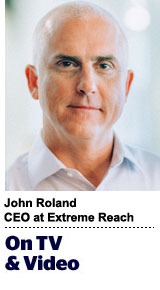 “On TV And Video” is a column exploring opportunities and challenges in programmatic TV and video.
“On TV And Video” is a column exploring opportunities and challenges in programmatic TV and video.
Today’s column is written by John Roland, CEO at Extreme Reach.
The advertising industry is in a state of perennial disruption. As new screens and services emerge, the viewing experience morphs – requiring advertisers to change the way they reach consumers. Or so it seems.
As media consumption habits trend from analog toward multiple, fragmented digital devices, it is a common refrain that TV – and, with it, the heyday of audience reach – is dead.
The latest challengers are vertical video, interactive ads, micro-commercials and native. But they all succumb to the same intrinsic failings: too much extra production required, at too high an outlay, for too small of an audience.
What is real is “shiny object syndrome,” when we are blinded by brand-new ad formats despite an absence of data proving they perform any better than the models they seek to unseat. That’s why I see the tide turning back; the 15-second and 30-second spots are going to have a long life yet.
Sure, no one can dismiss that Snapchat is turning the ad world on its head. Its 3V video ad format espouses the value of producing video ads in an aspect ratio designed for the mobile screen, which for many users is the primary screen. But, while Snapchat says vertical video ads perform nine times better than traditional ones, very few creative agencies have been drawn to this new design. Doing so would require that the buy side change everything it does, shooting in yet another custom format for yet another individual platform.
Same goes for native. Many marketers want to reach audiences with material that looks and performs like the content they came to consume. But, because a native ad tends to require delivery by a single publisher or broadcaster whose tone it matches, it necessarily cannot travel very far. It also doesn’t come cheap – a good native execution can cost six figures for just a single publisher and tends to be short-lived.
The latest shiny video ad format touts hoverable, clickable widgets, hotspots and overlays as heralding greater engagement. True, immersion can promise previously unheard-of levels of engagement. But off-the-scale engagement comes at a price, with insufficient ad space to go around. Even now only about half of publishers support the VPAID video tag required to deliver interactive executions.
Advertisers don’t have enough time in the day or large enough budgets to create for every new publisher ad format on the horizon. They want reach and frequency with quality and scale. Yes, advertisers want to get their content in front of people on different devices. But if you are Ford controlling a $900 million annual advertising budget and needing to sell billions of dollars of automobiles, you can’t spend it all on shiny, fragmented channels.
Turns out the best way to do that is by borrowing from an old medium. The commercial TV spot may date back to the 1940s, but, in an age of device proliferation, it is supremely transportable. The 15-second and 30-second spots aren’t relics – they are the building block of the future of media.
Digital-native publishers and social networks that had been grasping for the newest format are now rediscovering the power of the video ad template developed by TV decades ago.
Introduced in December, Facebook’s Premium Video Ads come in 15- and 30-second flavors, promise a “large audience” and “high quality” and even use TV-style gross rating points and Nielsen for measurement.
Snapchat, which previously only offered 10-second mobile video ads, is now running longer, with 15-, 30- and even 60- and 90-second creatives on offer to big, familiar buyers like Unilever, Fox and Paramount. Twitter, too, has lifted the stingy six-second time limit on its video pre-rolls to 30 seconds and longer, while Instagram, not to be left out, has gone up to 60 seconds.
These networks are done with convincing ad buyers to march to their tune – they want a slice of the $75 billion US TV advertising spend, and the best way to get it is to let advertisers reach audiences in the way they are already doing.
TV-style ad lengths create commonality in the industry that everyone can work with, and are as familiar to consumers as they are to producers. Recognizing the TV ad as the common unit of video advertising will help propel the entirety of all-screen video advertising.
Follow Extreme Reach (@extremereach) and AdExchanger (@adexchanger).












